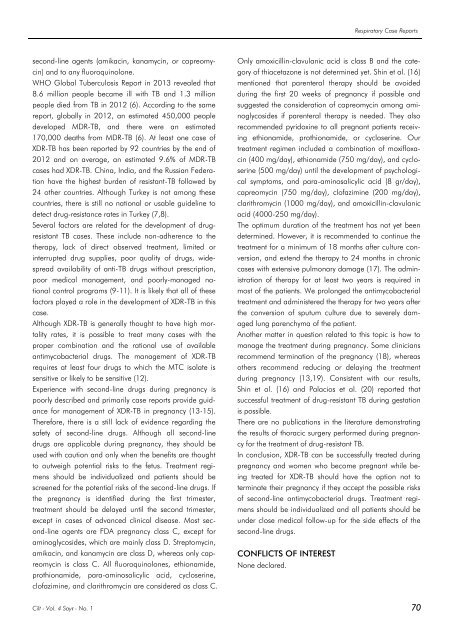Respircase Cilt: 4 - Sayı: 1 Yıl: 2015
Create successful ePaper yourself
Turn your PDF publications into a flip-book with our unique Google optimized e-Paper software.
Respiratory Case Reports<br />
second-line agents (amikacin, kanamycin, or capreomycin)<br />
and to any fluoroquinolone.<br />
WHO Global Tuberculosis Report in 2013 revealed that<br />
8.6 million people became ill with TB and 1.3 million<br />
people died from TB in 2012 (6). According to the same<br />
report, globally in 2012, an estimated 450,000 people<br />
developed MDR-TB, and there were an estimated<br />
170,000 deaths from MDR-TB (6). At least one case of<br />
XDR-TB has been reported by 92 countries by the end of<br />
2012 and on average, an estimated 9.6% of MDR-TB<br />
cases had XDR-TB. China, India, and the Russian Federation<br />
have the highest burden of resistant-TB followed by<br />
24 other countries. Although Turkey is not among these<br />
countries, there is still no national or usable guideline to<br />
detect drug-resistance rates in Turkey (7,8).<br />
Several factors are related for the development of drugresistant<br />
TB cases. These include non-adherence to the<br />
therapy, lack of direct observed treatment, limited or<br />
interrupted drug supplies, poor quality of drugs, widespread<br />
availability of anti-TB drugs without prescription,<br />
poor medical management, and poorly-managed national<br />
control programs (9-11). It is likely that all of these<br />
factors played a role in the development of XDR-TB in this<br />
case.<br />
Although XDR-TB is generally thought to have high mortality<br />
rates, it is possible to treat many cases with the<br />
proper combination and the rational use of available<br />
antimycobacterial drugs. The management of XDR-TB<br />
requires at least four drugs to which the MTC isolate is<br />
sensitive or likely to be sensitive (12).<br />
Experience with second-line drugs during pregnancy is<br />
poorly described and primarily case reports provide guidance<br />
for management of XDR-TB in pregnancy (13-15).<br />
Therefore, there is a still lack of evidence regarding the<br />
safety of second-line drugs. Although all second-line<br />
drugs are applicable during pregnancy, they should be<br />
used with caution and only when the benefits are thought<br />
to outweigh potential risks to the fetus. Treatment regimens<br />
should be individualized and patients should be<br />
screened for the potential risks of the second-line drugs. If<br />
the pregnancy is identified during the first trimester,<br />
treatment should be delayed until the second trimester,<br />
except in cases of advanced clinical disease. Most second-line<br />
agents are FDA pregnancy class C, except for<br />
aminoglycosides, which are mainly class D. Streptomycin,<br />
amikacin, and kanamycin are class D, whereas only capreomycin<br />
is class C. All fluoroquinolones, ethionamide,<br />
prothionamide, para-aminosalicylic acid, cycloserine,<br />
clofazimine, and clarithromycin are considered as class C.<br />
Only amoxicillin-clavulanic acid is class B and the category<br />
of thiacetazone is not determined yet. Shin et al. (16)<br />
mentioned that parenteral therapy should be avoided<br />
during the first 20 weeks of pregnancy if possible and<br />
suggested the consideration of capreomycin among aminoglycosides<br />
if parenteral therapy is needed. They also<br />
recommended pyridoxine to all pregnant patients receiving<br />
ethionamide, prothionamide, or cycloserine. Our<br />
treatment regimen included a combination of moxifloxacin<br />
(400 mg/day), ethionamide (750 mg/day), and cycloserine<br />
(500 mg/day) until the development of psychological<br />
symptoms, and para-aminosalicylic acid (8 gr/day),<br />
capreomycin (750 mg/day), clofazimine (200 mg/day),<br />
clarithromycin (1000 mg/day), and amoxicillin-clavulanic<br />
acid (4000-250 mg/day).<br />
The optimum duration of the treatment has not yet been<br />
determined. However, it is recommended to continue the<br />
treatment for a minimum of 18 months after culture conversion,<br />
and extend the therapy to 24 months in chronic<br />
cases with extensive pulmonary damage (17). The administration<br />
of therapy for at least two years is required in<br />
most of the patients. We prolonged the antimycobacterial<br />
treatment and administered the therapy for two years after<br />
the conversion of sputum culture due to severely damaged<br />
lung parenchyma of the patient.<br />
Another matter in question related to this topic is how to<br />
manage the treatment during pregnancy. Some clinicians<br />
recommend termination of the pregnancy (18), whereas<br />
others recommend reducing or delaying the treatment<br />
during pregnancy (13,19). Consistent with our results,<br />
Shin et al. (16) and Palacios et al. (20) reported that<br />
successful treatment of drug-resistant TB during gestation<br />
is possible.<br />
There are no publications in the literature demonstrating<br />
the results of thoracic surgery performed during pregnancy<br />
for the treatment of drug-resistant TB.<br />
In conclusion, XDR-TB can be successfully treated during<br />
pregnancy and women who become pregnant while being<br />
treated for XDR-TB should have the option not to<br />
terminate their pregnancy if they accept the possible risks<br />
of second-line antimycobacterial drugs. Treatment regimens<br />
should be individualized and all patients should be<br />
under close medical follow-up for the side effects of the<br />
second-line drugs.<br />
CONFLICTS OF INTEREST<br />
None declared.<br />
<strong>Cilt</strong> - Vol. 4 <strong>Sayı</strong> - No. 1 70

















